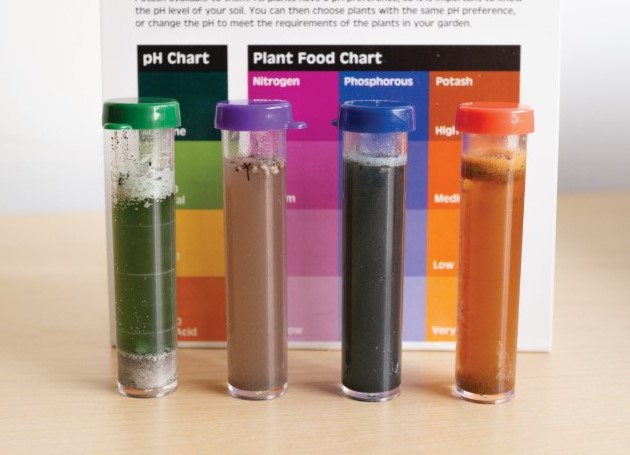MSU Press Release: Soil test kits vs. laboratory tests

DYI home soil test kit. Image by MSU Extension.
There are several factors that gardeners need to consider when choosing a soil test kit to make fertilizer decisions. Among those factors are how soil is prepared, the actual test used, how results are presented, cost and the accuracy of results.
Test kits generally measure nitrogen, phosphorus, potassium and soil pH. These are appropriate basics, though a laboratory test can also measure salts or a host of other nutrients, such as iron, which may be important for gardeners to know.
Most soil test kits require combining the soil sample with water to make a slurry. In contrast, soil testing laboratories dry, sort, grind and sieve soils to remove rocks and residue.
Particularly important is the quality and shelf-life of the reagents (chemical liquids) mixed with the soil to perform each test. Laboratories have standard practices to ensure their materials are not out-of-date. Just like using outdated milk, using an old batch of reagent might not have desirable results.
Soil test kits may not include the correct phosphorus test. The Olsen P test is accurate for soils with pH greater than 6, while the Bray or Mehlich tests are accurate for soil pH less than 7.3. MSU fertilizer guidelines are based on Olsen P values, because most Montana home garden and agricultural soils have a pH greater than 6. There is no simple conversion from Bray or Mehlich to Olsen P values. Even when submitting a sample to a laboratory, it is important to request the Olsen P test, rather than the Bray or Mehlich test, if soil pH is greater than 6.
Many test kits provide results with a word-based rating of “low,” “medium” or “high” — or “deficient,” “adequate” or “surplus” — rather than in a unit value, such as parts per million or pounds per acre. Laboratories report unit values and fertilizer recommendations based on field trials that provide the relationship between fertilizer rates and soil test values.
Test kits can be cheaper and more convenient, but, the savings may not be worth the generalized results. Kits cost in the range of $15 for 10 samples to $750 for 100 samples. A commercial gardener or community gardening cooperative may use 100 samples’ worth of material in an elaborate kit, while a home gardener likely would not.
Laboratories can have quick turnaround, and although lab fees can vary from around $15 to over $50 per sample, accurate results are available from labs with low fees. It is better to spend $15 on accurate results than base fertilization on erroneous results and potentially cause fertilizer waste, environmental degradation or lost production. County agriculture Extension agents can likely help people choose a laboratory to work with.
A recent article in “Crops and Soils,” which is published by American Society of Agronomy, discussed the testing of four soils using four test kits and compared the results with laboratory results. The kit that provided two options for testing soil phosphorus and required users to sort, dry and grind the soil before mixing it with specific chemical reagents provided results very similar to laboratory results. The results from simpler kits differed moderately or even highly from laboratory results.
More information on soil fertility of home gardens is available at the MSU Soil Fertility Extension website at http://landresources.montana.edu/soilfertility/home-gardening.html and from the MSU Master Gardener program at https://mtmastergardener.org/. Or, contact Clain Jones at 406-994-6076 or clainj@montana.edu.
Posted May 2019
